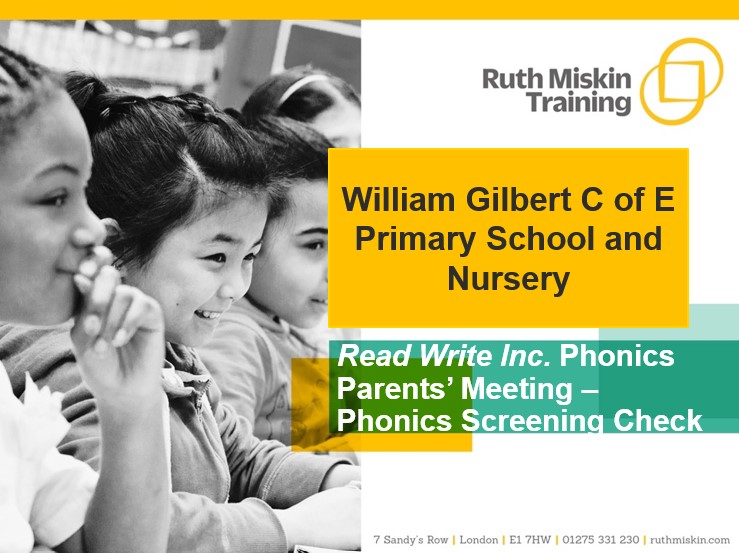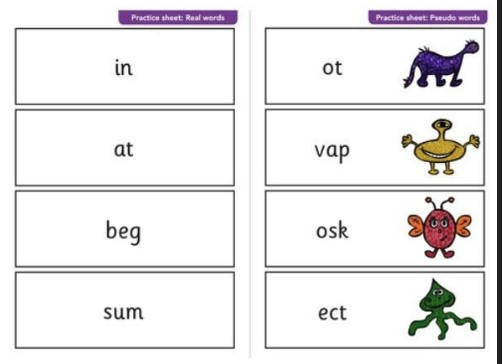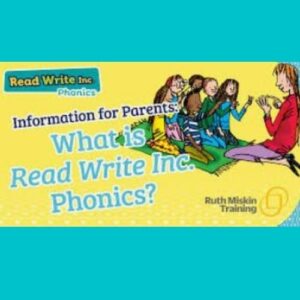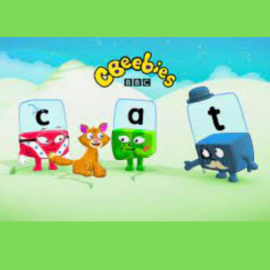Phonics

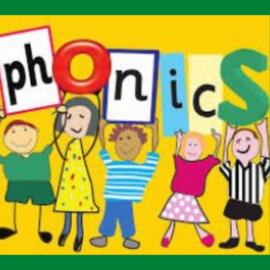
Early reading starts with phonics. At William Gilbert early reading is taught using synthetic phonics following the Ruth Miskin’s scheme ‘Read Write Inc’. Using this approach, children learn to read swiftly and are free to put their energy into comprehending what they read. It also allows them to spell effortlessly so that they can put all their energy into composing what they write.
What is phonics?
Phonics is a way of teaching children to read quickly and skilfully. They are taught how to:
- Recognise the sounds that each individual letter makes;
- Identify the sounds that different combinations of letters make – such as ‘sh’ or ‘oo’
- Blend these sounds together from left to right to make a word.
- Children can then use this knowledge to ‘decode’ new words that they hear or see. This is the first important step in learning to read.
Why phonics?
Research shows that when phonics is taught in a structured way – starting with the easiest sounds and progressing through to the most complex – it is the most effective way of teaching young children to read. It is particularly helpful for children aged five to seven.
Almost all children who receive good teaching of phonics will learn the skills they need to tackle new words. They can then go on to read any kind of text fluently and confidently, and to read for enjoyment. Children will also become confident phonetic spellers. This will then lead into teaching the children different spelling rules to help develop more accurate spelling.
What do we do?
At William Gilbert we believe parental involvement makes a huge impact on the children’s love for reading. You begin the reading journey by communicating with your children, singing, sharing books and exploring sounds. Reading begins with listening.
Nursery: The aim in Nursery is to foster children’s listening and speaking skills as preparation for learning to read with phonics. The children will also have carefully planned activities that develop the skills needed before learning phonics. These skills are as follows:
- Spoken language – Children will learn spoken language, the ability to listen carefully and respond through rich language experiences. The adults are skilful in their communication often saying more is necessary to develop children’s understanding of language. There will be opportunities for silence and careful listening, play and interaction that enable them to engage in talk.
- Physical activity – This supports sensory awareness and integration. Children will develop a range of physical skills to be able to engage effectively in learning, including being able to sit still and focus. This includes, balance and proprioception, crossing the midline, and sensory awareness and integration. These skills are not developed by sitting still. Young children need to be active; to move and have opportunities for vigorous activity to develop these physical foundations for learning.
- Meta-linguistic awareness – In order to access our phonics teaching with success children need to be able to think and talk about language. Children will develop this awareness through language-play, and through reading storybooks in ways that draw children’s attention to language.
- Environmental print – Becoming literate needs a context. Children in our setting will develop an understanding of why, where and how print (including digital print) is used, so that learning phonics and to read and write are meaningful activities. Adults in the setting act as facilitators in children engaging with a print rich environment to support their emerging understanding, and use, of print.
- Symbolisation – Writing is the symbolic representation of speech, and reading is the decoding of symbols. Learning to symbolise requires that children make the cognitive shift from first to second-order symbolism. This is achieved through learning opportunities in nursery that facilitate children’s use of gesture and language, through symbolic use of resources in their play, and in mark marking.
- Phonological awareness – Phonological awareness begins and flows from the ability to hear, recognise and label environmental sounds. Children are supported in developing their ability to identify and orally manipulate units of language, such as identifying oral rhymes, and an awareness of aspects of language such as words, syllables and onset-rime.
Reception:
In Reception children have a daily phonics session with their class teacher. They will continue to be exposed to a learning environment that develops the crucial pre phonic skills introduced in nursery. The children will very quickly, within the first few weeks of starting school, begin learning the first set of sounds. All sessions are short, focused and of course fun! During Reception children will learn:
- How to represent each of the 44 phonemes by a letter or sequence of letters
- How to blend phonemes together for reading
- How to segment (split) words for spelling
- The letter names
- How to read and spell some Read, Write, Inc ‘red’ words e.g. they, my, you
Year 1: Children continue to learn within the Read, Write, Inc phonics programme, and will consolidate all previous learning. They will learn alternative ways of representing the same phoneme e.g. ai, ay, a-e. Children rapidly expand their ability to read and spell words with increasing challenge. They are also taught to read and spell words with more challenging and unusual spelling patterns e.g. chimpanzee. The phonics screening check is administered in June of year 1 and an information meeting for parents will be held in the spring term.
Year 2 : During this phase, children become fluent readers and increasingly accurate spellers. All children are taught phase 6 which is a focus on spelling- prefix, suffix, spelling rules, compound words, past tense and plural rules.
Phonics Screening Test
At the end of Year 1 children are assessed using the National Phonics Screening Test and this is repeated for those who did not achieve the appropriate level at the end of Year 2. This assessment gathers information on the children’s ability to blend and segment decodable words to read.
The children sit with Mrs Britten one to one in a relaxed environment and read 40 decodable words. If a child reads a word incorrectly, the teacher will just move onto the next word. Some words are real words and some are ‘pseudo’ or nonsense words (we describe these as the names of imaginary alien creatures). Below is a sample of 2 test pages. The test is very child friendly and is a great assessment tool for teachers.
In Year 2 – The children may or may not have passed. This information is carried to year 2 where we ensure the children are supported. We identify gaps and provide extra group work to support these children daily. Some children pass but may still need confidence building or help to apply their knowledge to their writing. All children are taught phase 6 which is a focus on spelling- prefix, suffix, spelling rules, compound words, past tense etc. The children who did not pass the check will get the chance to take it again in June.
After Year 2- Some children may still need support with their reading, writing and confidence in this area. Teachers communicate the children’s needs and parents are informed on progress. Children will be part of our provision map to ensure support carefully matches their needs and quickly diminishes the difference and closes the gap in attainment.
How we teach Phonics
The ‘Read Write Inc’ scheme sets out a detailed and systematic programme for teaching phonic skills. It is our aim that using this programme children start by the age of four and become fluent readers by age seven. Children are systematically taught the 44 phonemes that make up all the sounds required for reading and spelling.
As well as being taught to use their phonic skills and knowledge as their first approach to reading, children are also taught how to read high frequency words called ‘red words’.
‘Red words’ are words that cannot be ‘sounded-out’ but need to be learned by heart. They don’t fit into the usual spelling patterns. In order to read simple sentences, it is necessary for children to know some words that have unusual or untaught spellings.
The teaching of phonics is of high priority to all staff. We ensure that our teaching of phonics is rigorous, structured and enjoyable. Children have discrete, daily phonics sessions where they are introduced to new phonemes, can practise and revise previous learning and have plenty of opportunities to apply the knowledge they have.
As a school, we have clear expectations on our children’s phonics progress term-by-term, from Reception to Year 2. We regularly assess children’s phonics progress with the support of an assessment tool called Phonics Tracker.
Children work with pace and are encouraged to apply their knowledge across the curriculum with any reading or writing activities.
We are committed to investing in high-quality phonetically decodable reading books in school. Quality time is given to children to practise reading and re-reading books that match the grapheme-phoneme correspondences they know, both at school and at home.
Home Support

Throughout the year we hold a number of parent workshops to support with all aspects of phonics.
Early Reading – Information Presentation for Parents
Year 1 Reading & Curriculum
Year 2 Reading & Curriculum (coming soon)
Some useful websites
If you would like to find out more about phonics, visit the phonics section of the Department for Education Website (Click Here)
Teach your Monster to Read – Reading and phonics support
Cbeebies Alphablocks – Reading and phonics support
We are committed to supporting all of our parents in becoming skilled and confident in supporting their child’s phonics. Further information on supporting children’s phonics at home can be found below.
Further information to support your child’s phonics at home can be found below.
Key Stage 1 Phonics Screening Check?
The Year 1 phonics screening check is not a formal test, but it is a ‘light touch’ statutory assessment that schools must administer. It gives a view of pupils ability to apply their phonic skills and if they have reached age related expectations. The phonics screening check is taken individually by all children in Year 1 in England during the month of June. It is designed to give teachers and parent’s information on how your child is progressing in phonics. It will help to identify whether your child needs additional support at this stage so that they do not fall behind in this vital early reading skill.
What is in the Phonics Screening Check?
The Phonics Screening check consists of 40 words that assess phonics skills and knowledge learned throughout Reception and Year 1. There is a combination of 20 real words and 20 ‘pseudo-words’ (nonsense words/’alien’ words). Children sit the check on a 1:1 basis with their class teacher. There is no time limit but children normally complete the check in one sitting (around 5-10 minutes). It is not a stressful situation: your child’s class teacher will be well-equipped to listen and understand your child’s level of skills. There will be a few practice words first to make sure your child understands the activity and feels comfortable.
What are nonsense/pseudo words and why are they included?
These are words that are phonically decodable but are not actual words with an associated meaning e.g. brip, snorb. Pseudo words are included in the check specifically to assess whether your child can decode a word using phonics skills and not their word memory.
The pseudo words will be shown to your child with a picture of an alien and they will be asked to tell their teacher what sort of alien it is by reading the word. This not only makes the check a bit more fun, but provides the children with a context for the nonsense word which is independent from any existing vocabulary they may have. Crucially, it does not provide any clues, so your child just has to be able to decode it. Children generally find ‘alien words’ amusing so they will probably enjoy reading these words!
Is there a pass mark?
Since first introducing the phonics screening check, the government has set the ‘pass rate’ at 32 marks (out of 40). However, the check is not about ‘passing or failing’ but assessing if appropriate progress is being made. If children do not reach the required standard, then we will offer additional, tailored support to ensure that your child can catch up. Children progress at different speeds so not reaching the threshold score does not necessarily mean there is a serious problem. Your child will re-sit the check the following summer term in Year 2.
What happens to the results?
We will report your child’s results to you by the end of the summer term as well as to the local authority. The schools results are not published to the general public. Ofsted can access the schools results as one of the schools performance measures. If you have any concerns, do talk to your teacher about this in a parents’ meeting or after school. We run a f parent workshop regarding the phonics screening check in the spring term which year 1 parents will be invited to attend.
Do all schools and children have to participate?
All schools and academies in England must take part in the phonics screening check unless they are an independent school. There is a process in place for reviewing children with special educational needs, so if your child’s teacher thinks there are very special reasons related to your child and their needs that make them think the phonics screening check may not be appropriate, they will decide on appropriate action and discuss this with you.
Further areas for supporting your child prepare
Phonics Screening Parent Workshop – CLICK HERE

